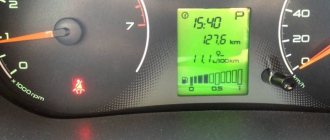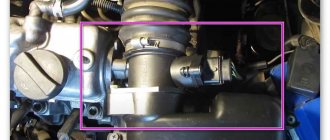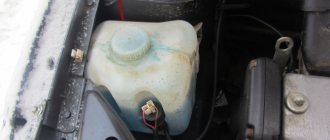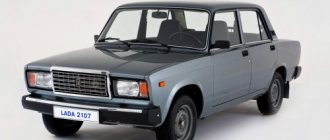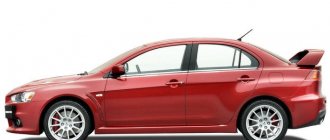The main indicator of economical operation of a car engine is specific fuel consumption. There are several methods for determining it. Every manufacturer wants their cars to have this figure as low as possible. Therefore, the methods for determining gasoline consumption differ from one another. The Russian manufacturer represented by AvtoVAZ claims that the fuel consumption of the Lada Granta averages 6.7-7.7 l/100 km in the combined driving cycle. However, passport data does not always coincide with actual results.
How are fuel consumption standards determined?
Gasoline consumption is determined in laboratory conditions. There are special techniques for this. For example, in Europe, consumption is determined according to NEDC standards - the new European driving cycle. The standard was last updated in 1997. Its disadvantage is that the choice of vehicle and test conditions is at the discretion of the automaker. Instead of a new car, a run-in version of the tested model can be used and almost perfect conditions created for this (windows closed, air conditioning, headlights and MMC turned off, etc.).
To simulate driving in the city and on the highway, different testing times are selected. Special rubber and low viscosity lubricating oil may be used. The presence of these factors leads to the fact that gasoline consumption standards appear in the car's passport, which are far from the true ones. The American and Japanese methods are more stringent, so the documents indicate values that are close to objective. In some cases, if you buy a car with a passport consumption of 7.5 liters per 100 km, in reality it turns out that it consumes 10-12 liters. This figure may increase depending on the season, fuel quality, load, road and engine conditions and many other factors. Therefore, drivers themselves try to determine specific fuel consumption and take measures to reduce it.
How are consumption rates determined?
Fuel consumption, that is, the amount of gasoline consumed per 100 km, is recognized in many countries as one of the most important characteristics of a car engine. Vehicle weight, engine efficiency, transmission ratios, power consumption of additional equipment, tire quality, fuel pump operation, braking and other factors affect specific fuel consumption. Aggressive, overly active driving also requires higher gas mileage.
In the recent past, fuel consumption calculations were determined by professional drivers during factory tests on specially equipped tracks. At the moment, the new principle of such testing shows high reproducibility of the results. But when a standardized test is carried out in a testing laboratory, the car is in good condition, filled with reference fuel, all additional electrical equipment, air conditioning and lighting are turned off. The stand automatically performs cycles of uniform motion and acceleration and deceleration.
Manufacturers publish data obtained on a test bench, which is not the norm for practical gasoline consumption. An aggressive driving style and second-to-second acceleration, engine problems and fuel metering systems, low tire pressure and vehicle load, jammed brakes and transmission malfunction are not all the reasons for incomplete combustion of fuel and, as a result, a significant increase in gasoline consumption. If the car is technically in good working order, then in normal driving conditions an experienced driver will be able to reduce fuel costs.
You should know that fuel consumption increases in winter, on mountain roads, and when transporting large cargo. Cars from the assembly line, with the air conditioner running, as well as engines after major overhauls, consume more fuel.
What factors influence the fuel consumption of the Lada Granta?
Fuel consumption when driving under standard conditions depends on the following factors and is:
- driving - 60%;
- operation at full air conditioner power - 15%;
- driving on a cold engine - 12%;
- traveling with lights on - 5%;
- open windows at speeds over 50 km/h - 4%;
- low tire pressure - 4%.
Gasoline consumption on the Lada Granta may increase due to:
- low quality fuel;
- using tires that are not appropriate for the season;
- unsatisfactory condition of the engine and systems serving it;
- aggressive driving style;
- condition of the road surface;
- use of powerful additional electrical equipment;
- installing a trunk, air box or driving with a trailer.
In winter, when the engine warms up, fuel consumption increases by 1.5-2 liters. Driving around the city during rush hour significantly increases fuel consumption. In some cases, consumption can reach 15-19 l/100 km.
Using gasoline with a low octane number not only increases its consumption, but also leads to engine overheating.
Fuel consumption of 8-valve engines
The first copies of the Lada Granta, which appeared in 2011, were equipped with gasoline injection engines models 11183 and 11186 with a volume of 1.6 liters and a power of 82 and 87 hp. respectively. The use of a power supply system with distributed injection and a lightweight connecting rod and piston group made it possible to achieve a reduction in consumption in all driving modes. With a combined cycle, the 82-horsepower Lada Granta has a gasoline consumption of 7.4 liters, and with the 11186 engine - 7.0 liters per 100 km. When driving in the city it will be 9.7 and 9.0 l/100 km, and on the highway - 6.1 and 5.8 l/100 km, respectively.
In fact, the fuel consumption of the sedan differs significantly from the official data: outside the city it is about 6.6 liters, and in the combined cycle - 8.5 l/100 km. Differences in fuel consumption largely depend on the operation of the vehicle under conditions that differ significantly from laboratory conditions (ground tests). The use of low quality fuel and lubricants makes a significant contribution.
Gasoline consumption
Fuel consumption on an 8-valve engine averages 7.4 liters in the combined cycle, 6 liters on the highway and 8.7 liters in the city. I was pleasantly surprised by the owners of cars of this model, who tell on the forums that the real fuel consumption on an 8-valve Lada Granta with an engine power of 82 hp. slightly exceeds the norm: 9.1 liters in the city, 5.8 liters in the extra-urban cycle and about 7.6 liters during mixed driving.
The actual fuel consumption of the Lada Granta is 87 liters. With. differs from the specified standards: city driving 9 liters, mixed - 7 liters and country driving - 5.9 liters per 100 kilometers. A similar model with a 90 hp engine. consumes no more than 8.5-9 liters of fuel in the city and 5.8 liters on the highway.
In other words, these VAZ models can be called the most successful budget models of the Lada Granta car. In winter, fuel consumption increases by 2-3 liters per 100 km.
Cars with 16 valve engine
The engine configuration with 16 valves contributes to a significant increase in engine power. Such Lada Granta models have the same 1.6 liter engine with a power of 98, 106 and 120 (sport version model) horsepower and are equipped with an automatic and manual transmission.
Technical characteristics also include front-wheel drive and an engine with distributed fuel injection. The maximum acceleration speed reaches 183 km/h, and the first 100 kilometers can be reached after 10.9 seconds of driving.
Fuel consumption of 16-valve engines
Installing 4 valves per cylinder made it possible to reduce the load on the engine, which had a positive effect on reducing fuel consumption and at the same time increasing the power of the power unit. The cars were equipped with engines 21126 (98 hp) and 21127 (106 hp) with a volume of 1.6 liters. Frets with such engines had both a mechanical and a robotic gearbox. According to the passport data, fuel consumption standards per 100 km for cars with a 98 hp power unit. are:
- urban cycle - 9.9 l;
- highway - 6.1 l;
- mixed cycle - 7.6 l.
Despite the fact that the 21127 engine has more power, it consumes slightly less fuel:
- city roads - 8.6 l;
- highway - 5.6 l;
- mixed cycle - 6.7 l.
Actual costs differ from the passport costs and amount to 10-12 liters for the city and 7 -7.5 liters when driving on suburban highways.
Features of consumption depending on the gearbox
Cars with an automatic transmission (automatic transmission) consume more fuel than those with a manual transmission (manual transmission).
This is due to the fact that the robot switches gears with a delay, i.e., to switch to a higher gear, higher engine speeds are required than with a manual transmission.
This is especially noticeable when driving within the city. Gasoline consumption for cars with automatic transmission in this case is 11-12 l/100 km. On the highway, these figures are slightly lower and fluctuate between 7.5-8.5 l/100 km. In winter, gasoline costs increase by 2-2.5 l/100 km. On cars with a manual transmission, fuel consumption under the same conditions is 2-3 liters less.
Due to the high cost and high fuel costs, cars with a robotic gearbox are in less demand among potential Lada Granta owners.
How to measure fuel consumption yourself
On car enthusiast forums you can often find messages that their Ladas consume from 14 to 18 l/100 km when driving around the city or 8-9 l when driving outside the city. Despite the presence of an on-board computer, many car owners try to calculate specific fuel consumption themselves. It happens that the result is less than the computer readings, and sometimes vice versa. In this case, you must contact a service station to diagnose the engine.
Test lamp method
To ensure accurate fuel consumption measurements, you must drive at least 1 thousand km. When the minimum fuel reserve warning light comes on, less than 7 liters of gasoline remains in the tank. The car is filled with fuel until the gas tank is full. After this, the odometer is reset, and the car is operated in everyday mode until the light comes on. The car is filled with AI 95 gasoline and so on until the mileage is 1 thousand km. After the next signal lights up, readings are taken and the average fuel consumption is determined.
The calculation is carried out using the formula: (V/L)x100, where V is the total amount of gasoline filled, and L is the control mileage of the car. If the result differs from the passport data and exceeds 10 liters, check the serviceability of the systems. To do this, the on-board computer readings are reset and a test drive is carried out on an open road at a constant speed of 80-90 km/h.
The mileage per trip should be 5-10 km. If, as a result of measurements, the consumption according to the on-board computer is in the range of 4.5-5.5 liters, it means that the engine is working normally, and the increased fuel consumption is associated with driving style or the congestion and condition of the roads. Otherwise, you need to contact a car service.
From tank to tank
With this method of determining the average fuel consumption, the result is less accurate than in the previous one, but it will qualitatively show the excess or value of the specified fuel consumption. To do this, the odometer and computer readings are reset, and the fuel tank is filled up to the neck so that the gasoline level is visible. The vehicle must travel at least 300 km in various modes. The longer the mileage, the more accurate the result will be.
After all the gasoline has been used up, the car is refueled to the same level as before taking measurements. The average consumption is determined by the same formula as in the previous case. The calculated data is compared with computer readings. If the difference is large, then it is necessary to check the readings and, if necessary, calibrate the fuel consumption on the device.
Measurement results may vary due to the quality of gasoline. Therefore, it is recommended to carry out measurements while replenishing fuel at one gas station. In case of increased consumption, you need to measure it while refueling at a gas station of another network.
Got in and drove off or what?
There are things that I recommend doing right away. It is advisable to check the wheel alignment without delaying
. I had no questions about the pre-restyling car - I drove it without problems with the wheels up to 50,000 km. But the updated liftback and similar Grants from friends were slightly eating away at the outer part of the tread on the front tires. Exactly so much that it can be attributed to the imperfect quality of cheap tires. Indeed, the steering wheel is straight, the car does not pull anywhere while driving, the run-out is good, and fuel consumption is low. But I stopped by to check so as not to guess on the coffee grounds. The officials announced about five thousand rubles for the operation! Result: caster and camber are normal. Moreover, the parameters for the left and right wheels have very minimal discrepancies. The problem was with the toe-in - a slight fall out of the tolerance range. Simply put, the wheels were spinning a little. The shoes have been rehabilitated. I understand that two new 14-inch Artmotion tires from Belarus will cost less than checking wheel alignment angles from the officials. But there is also a winter set.
I’ll mention a couple of very useful and inexpensive modifications that are best done in the first days of operation. The first is a self-adhesive seal for the gap between the upper edge of the windshield and the roof
(pictured above).
In this area, the paint is highly susceptible to abrasive wear. The second is cheap plastic tubes for upgrading the seals of the sliding windows
. Grant has one drawback - the slightly open windows rattle unpleasantly in the openings. The tubes are pushed into the seal and the itching disappears. The modification does not interfere with the operation of the power window.
